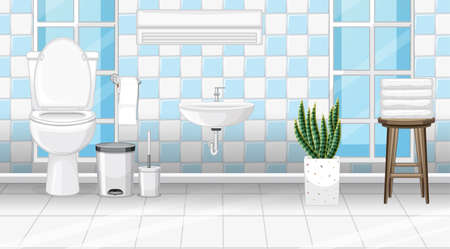Sustainable Materials and Eco-Friendly Choices
As we head into 2025, sustainability is taking centre stage in British bathroom design. Homeowners across the UK are increasingly opting for materials and products that minimise their environmental impact while delivering both style and durability. This shift towards eco-consciousness is reflected in several key trends.
Recycled and Renewable Materials
Modern British bathrooms are embracing recycled glass tiles, reclaimed wood vanities, and bamboo accessories. These materials not only reduce waste but also add a unique character to each space. Choosing locally sourced or upcycled items helps lower carbon footprints and supports sustainable manufacturing within the UK.
Water-Saving Fixtures
With water conservation becoming a top priority, many households are installing low-flow toilets, aerated taps, and efficient showerheads. These fixtures are designed to cut down on water usage without compromising on performance, making them ideal for eco-conscious Britons.
| Eco-Friendly Feature | Typical UK Example |
|---|---|
| Recycled Glass Tiles | Bespoke mosaic splashbacks |
| Bamboo Accessories | Sustainable bath mats & storage |
| Low-Flow Toilets | Dual-flush cisterns |
| Aerated Taps | Mixer taps with flow restrictors |
Environmentally Conscious Products
The rise of eco-friendly cleaning solutions and organic toiletries in British bathrooms shows a holistic approach to sustainability. From biodegradable cleaning products to refillable soap dispensers, these choices further reduce environmental impact while maintaining high standards of hygiene and comfort.
Key Takeaways for 2025
- Embrace recycled and renewable materials to personalise your bathroom sustainably.
- Upgrade to water-saving fixtures to support conservation efforts.
- Opt for environmentally conscious products throughout your bathroom routine.
This growing focus on sustainable design not only benefits the planet but also creates healthier and more stylish living spaces for UK homeowners.
Bold Colours and Patterned Tiles
Across the UK, homeowners are moving away from the once-standard neutral tones and embracing a new era of vibrant, expressive bathrooms. Bold colours are making a splash, with deep navy blues, emerald greens, and rich terracottas topping the list of favourite hues for 2025. These daring shades are not just limited to paint—Britons are opting for coloured sanitaryware, lively cabinetry, and even painted ceilings to inject character into their spaces.
Patterned Tiles Take Centre Stage
Patterned tiles have become a go-to feature for those wanting to add personality and flair to their bathrooms. Whether it’s classic Victorian-inspired encaustic tiles or contemporary geometric patterns, these tiles serve as both practical surfaces and works of art. Statement walls using patterned tiles behind the basin or in shower enclosures are especially popular, helping to define focal points within the room.
Popular Colour & Tile Combinations
| Colour Palette | Tile Pattern | Application Area |
|---|---|---|
| Deep Navy & Brass Accents | Geometric Hexagons | Shower Feature Wall |
| Emerald Green | Mosaic Fish Scales | Splashback/Vanity Wall |
| Dusky Pink & Charcoal | Victorian Encaustic | Flooring |
Personalisation is Key
The British approach to bathroom design in 2025 is all about self-expression. From hand-painted murals to bespoke tile layouts, more people are seeking ways to make their bathrooms uniquely theirs. This trend towards boldness doesn’t mean sacrificing sophistication—many combine vibrant elements with classic British materials like porcelain and brushed brass for a look that is both modern and timeless.

3. Small Space Solutions
For many UK homeowners, making the most of a compact bathroom is a top priority in 2025’s design trends. With properties across the UK often featuring modestly sized bathrooms, clever space-saving strategies are essential. Below, we explore some of the most effective solutions to maximise every inch without compromising on style or functionality.
Smart Storage Ideas
One of the leading trends is integrated storage that blends seamlessly with your overall design. From recessed shelves to mirrored cabinets, these features help keep essentials tidy and out of sight. Modular wall-mounted units are particularly popular, offering flexibility and easy maintenance while freeing up valuable floor space.
Popular Space-Saving Fixtures
| Fixture Type | Benefits | Typical Application |
|---|---|---|
| Wall-Hung Toilets & Basins | Creates an illusion of more space; easy cleaning underneath | Narrow bathrooms and cloakrooms |
| Corner Sinks & Showers | Makes use of unused corners; opens up floor area | En-suites and small family bathrooms |
| Sliding Shower Doors | No outward swing required; maximises entry space | Compact shower cubicles |
| Recessed Shelving | Adds storage without protruding into room | Around baths and inside shower enclosures |
Clever Design Tips for Small Bathrooms
- Pale Colours: Light shades like soft greys, whites, or pastels reflect more light and visually expand the room.
- Large Format Tiles: Minimise grout lines to create a less cluttered look.
- Mirrored Surfaces: Mirrors bounce light around, giving a sense of depth and airiness.
- Tall Storage Units: Utilise vertical wall space for extra towels and toiletries.
- Bespoke Joinery: Tailor-made cabinetry fits awkward spaces common in UK homes.
Sustainable Choices for Compact Spaces
Sustainability remains a key concern for British households. Opting for water-saving dual-flush toilets, aerated taps, and energy-efficient LED lighting not only helps conserve resources but also suits smaller rooms by reducing clutter and bulk. These eco-friendly options fit perfectly with the trend towards practical yet responsible bathroom design in the UK.
4. Heritage and Vintage Influences
The return of heritage and vintage influences is making a significant impact on bathroom design across the UK for 2025. Homeowners are increasingly looking to evoke the grandeur and charm of bygone eras while incorporating modern comforts. British bathrooms are being transformed with Edwardian and Victorian aesthetics, featuring ornate details, classic fixtures, and period-inspired tiling. These traditional elements blend beautifully with contemporary conveniences, creating a space that feels both nostalgic and functional.
Blending Past and Present
One of the key trends is the seamless fusion of old and new. Roll-top baths, high-level cistern toilets, and pedestal sinks are paired with modern plumbing and discreet technology. This approach preserves the character of historical design while ensuring everyday practicality.
Popular Heritage Features in UK Bathrooms
| Feature | Edwardian/Victorian Influence | Modern Adaptation |
|---|---|---|
| Freestanding Bathtubs | Claw-footed cast iron baths | Lightweight acrylic versions with traditional styling |
| Tiling Patterns | Mosaic & geometric floor tiles | Durable porcelain tiles in classic designs |
| Basin Styles | Pedestal or console basins with decorative taps | Ceramic basins with water-saving mixers |
| Lighting | Sconces & chandelier fittings | LED lights in heritage-inspired fittings |
Materials & Finishes
Traditional British bathrooms often make use of rich materials such as brass, marble, and wood panelling. In 2025, expect to see these finishes updated for durability: unlacquered brass taps that develop a patina over time, engineered marble surfaces for easy maintenance, and moisture-resistant wood treatments.
Cultural Significance
This trend speaks to the UK’s appreciation for history and craftsmanship. By choosing heritage styles, homeowners celebrate local identity while enjoying timeless design. The result is a bathroom that’s not only practical but full of character—a true nod to Britain’s enduring architectural legacy.
5. Modern Technology and Smart Features
The modern British bathroom is swiftly evolving, embracing a host of smart technologies that promise to enhance comfort, efficiency, and convenience. As homeowners across the UK seek both style and substance in their bathroom renovations, integrating intelligent features has become a standout trend for 2025.
Smart Mirrors: Beyond Reflection
Today’s smart mirrors do much more than simply reflect your image. Equipped with LED lighting, anti-fog systems, and even Bluetooth speakers, these mirrors are rapidly becoming a must-have in contemporary UK bathrooms. Some models can display the weather forecast, news headlines, or even stream your favourite playlists while you get ready for the day ahead. This seamless blend of function and technology is designed to make daily routines smoother and more enjoyable.
Digital Showers: Precision Meets Luxury
Digital showers are making waves in British homes due to their precision temperature controls and programmable settings. With user-friendly digital panels or even smartphone integration, these showers allow you to pre-set your ideal water temperature and flow rate—ensuring every shower is just right. Some advanced models offer eco-modes to help conserve water, aligning with the UK’s increasing focus on sustainability.
| Feature | Benefits | Popular Brands in the UK |
|---|---|---|
| Smart Mirrors | Hands-free controls, built-in speakers, anti-fog tech | HiB, Roper Rhodes, Sensio |
| Digital Showers | Precise temperature control, remote operation, energy saving modes | Aqualisa, Mira Showers, Grohe |
| Underfloor Heating | Consistent warmth, energy efficiency, space-saving design | NexGen Heating, Warmup, ThermoSphere |
Underfloor Heating: Comfort All Year Round
Underfloor heating is quickly becoming a staple in British bathrooms, especially given the unpredictable UK climate. This feature provides gentle heat beneath your feet—eliminating cold tiles on frosty mornings and improving overall comfort without the need for bulky radiators. Thanks to advancements in energy-efficient technology and compatibility with various flooring types (from tiles to vinyl), underfloor heating is a practical luxury for any modern home.
Summary: A Smarter Bathroom Experience
The adoption of smart technology not only brings new levels of convenience but also adds value to UK homes. Whether it’s controlling your shower from your mobile or enjoying perfectly lit mirrors every morning, these innovations are redefining what it means to have a truly modern bathroom in 2025.
6. Open Showers and Wet Rooms
Open-plan showers and wet rooms have firmly established themselves as one of the leading bathroom design trends in the UK for 2025. Favoured for their clean lines, seamless integration, and minimalistic appeal, these designs are quickly replacing traditional shower cubicles in modern British homes. They offer a sense of spaciousness—even in smaller bathrooms—while also catering to accessibility needs, making them suitable for all ages and abilities.
Practical Benefits
| Feature | Benefit |
|---|---|
| No Shower Tray or Door | Easier cleaning and maintenance; fewer areas for mould and limescale build-up |
| Level Access | Step-free entry enhances safety for children, elderly, and those with mobility issues |
| Waterproofed Surfaces | Reduces risk of leaks and water damage; long-lasting protection for bathroom structure |
| Flexible Layouts | Customisable to suit any room shape or size, ideal for UK’s diverse housing stock |
Sleek, Contemporary Aesthetics
The hallmark of open showers and wet rooms is their streamlined appearance. Frameless glass panels, large-format tiles, and concealed drainage systems create an uncluttered visual flow. This approach not only maximises available light but also showcases premium finishes such as natural stone or textured ceramics—both popular choices in current UK interior design circles.
Maintenance & Structural Considerations
Proper installation is crucial for wet rooms to ensure longevity and prevent water ingress. This typically involves tanking (waterproofing) membranes beneath floors and walls, sloped flooring to direct water towards a central drain, and high-quality grouting materials. Regular upkeep—such as clearing drains and checking seals—will keep your wet room performing at its best while maintaining its contemporary allure.
Cultural Shift in UK Homes
The embrace of open showers and wet rooms reflects a broader shift in British preferences towards practical luxury and future-proof design. As homeowners prioritise both style and accessibility, expect this trend to remain at the forefront of bathroom renovations well beyond 2025.


